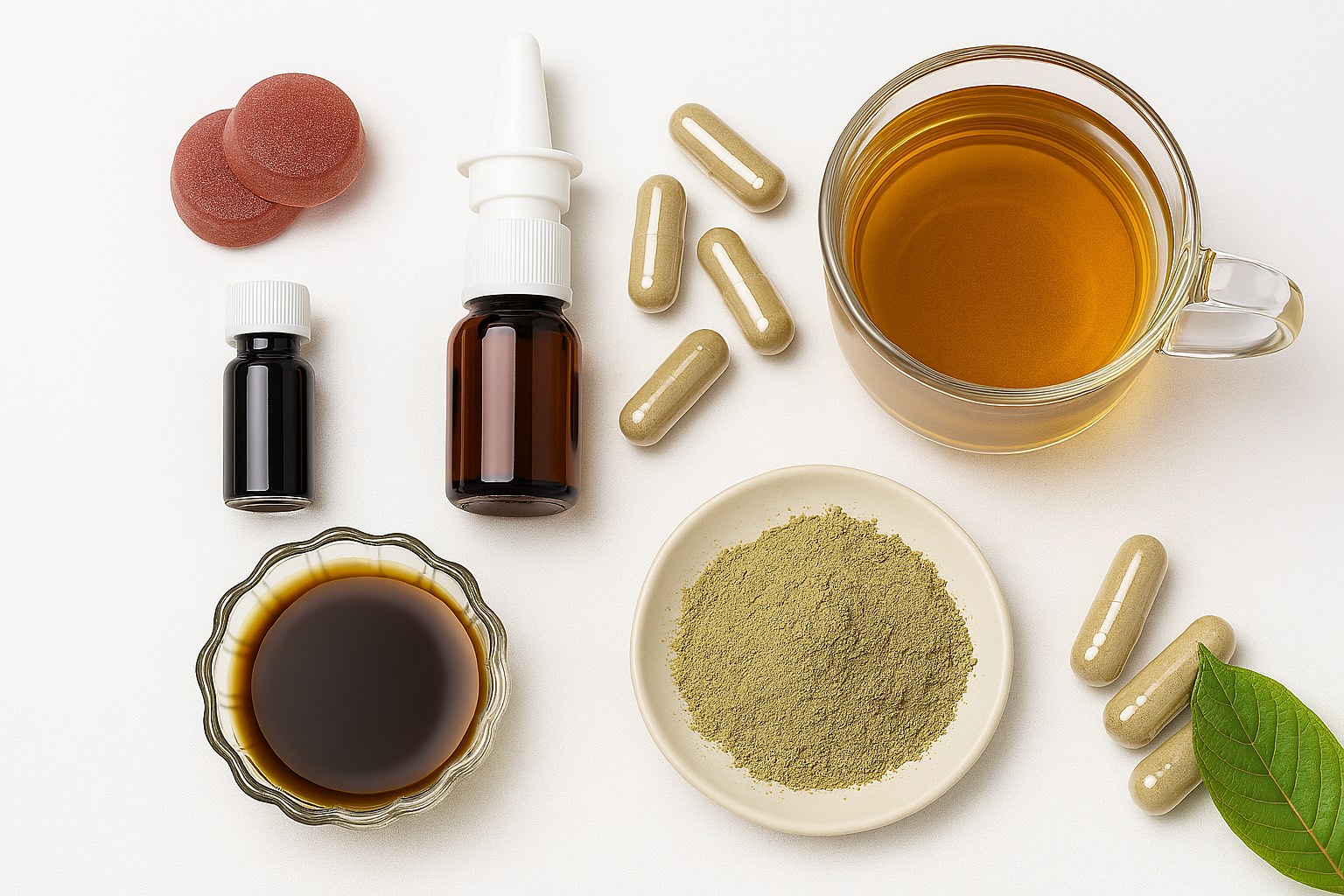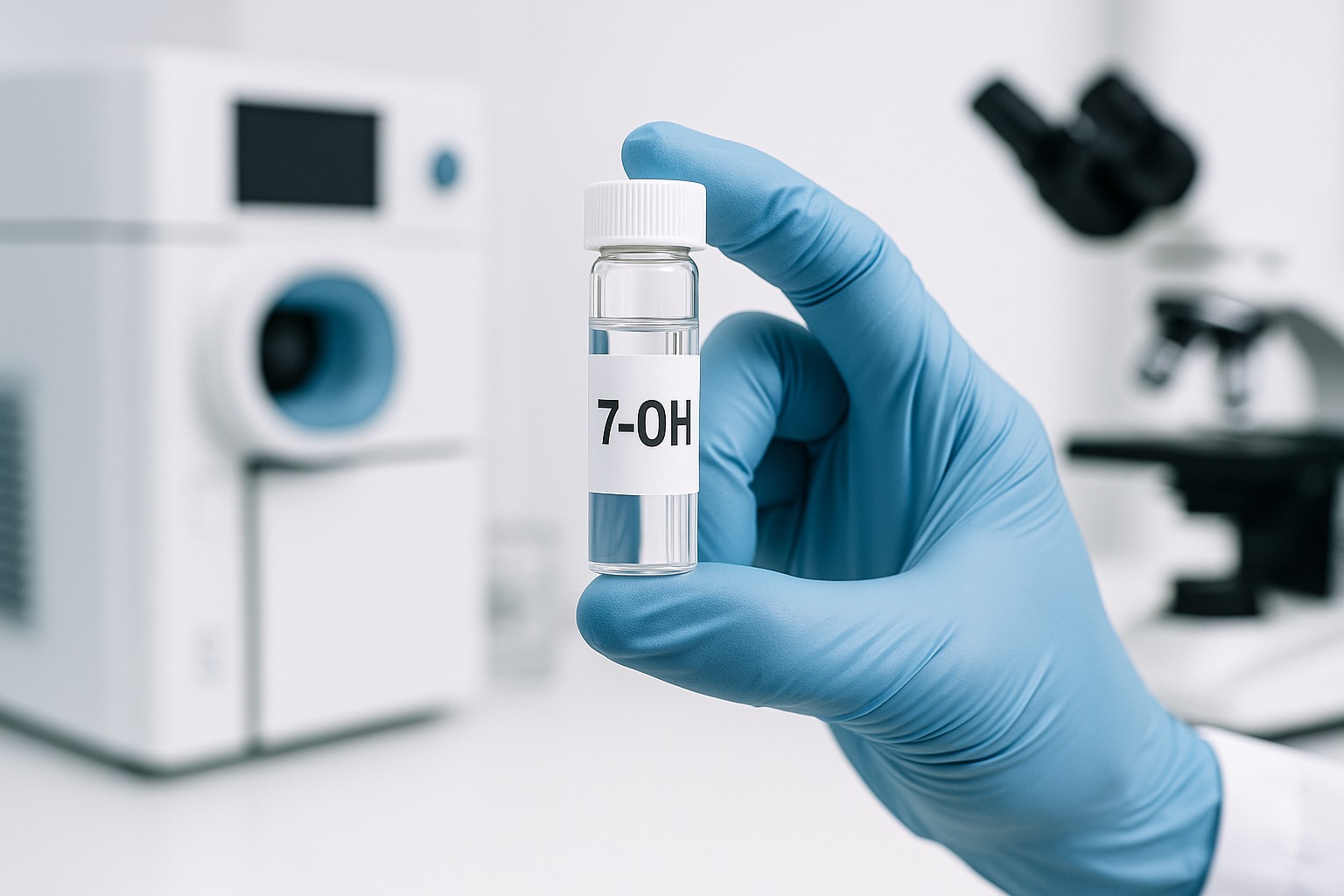Mitragynine and 7-hydroxymitragynine (7-OH) are the two primary active compounds in kratom. Both interact with the brain’s opioid receptors, but research suggests mitragynine may be safer because it poses less risk of adverse effects and misuse compared to 7-OH. This article compares mitragynine and 7-hydroxymitragynine potency and addictive potential and explains why kratom potency testing is key for ensuring product safety and effectiveness.
Mitragynine vs. 7-OH: Potency and Effects
Mitragynine is the dominant compound in kratom and drives most of its effects. At low doses, it tends to produce mild stimulation, increased energy, and improved mood. At higher doses, it can offer pain relief and gentle sedation.
7-hydroxymitragynine (7-OH) is far less abundant than mitragynine but far more potent at the opioid receptors. Even in small amounts, it produces stronger euphoric and sedative effects. This contrast in potency and experience helps explain why mitragynine is generally linked to lower misuse potential.
Mitragynine
Mitragynine is a naturally occurring kratom alkaloid (active compound) that primarily targets the mu-opioid receptor, like morphine. It also interacts with the delta-opioid receptor (DOR) and kappa-opioid receptor (KOR), but with lower strength. Additionally, some studies suggest mitragynine may influence serotonin (5-HT2A) receptors, which could play a role in its mood-related effects.
Mitragynine Potency: Mitragynine is about one-quarter as strong as morphine.
7-hydroxymitragynine
7-hydroxymitragynine (7-OH) is a metabolite of mitragynine that also activates mu-opioid receptors (MOR), similar to morphine. When the body metabolizes mitragynine in the liver, a portion is converted into 7-OH, which is significantly more potent despite being present in much smaller amounts in kratom.
7-OH Potency: 7-hydroxymitragynine binds to MOR with approximately five times the affinity of mitragynine. This function makes 7-OH about 10 to 13 times more potent than morphine and up to 40 times stronger than mitragynine.
Mitragynine vs. 7-OH: Potential for Misuse
Reports indicate up to 15 million Americans use kratom successfully as an alternative to opioids to alleviate undertreated chronic pain or to help symptoms of opioid withdrawal. Mitragynine and 7-OH both contribute to the plant’s positive effects in these areas.
- In a preclinical animal study, neither mitragynine nor 7-OH exhibited “rewarding effects,” referring to specific feelings of reinforcement in the brain that contribute to drug misuse.
- In a mouse study, combining mitragynine with morphine helped prevent the development of morphine tolerance.
- When taken from kratom whole-plant extracts, 7-OH appears to have milder withdrawal symptoms and a lower addictive profile than morphine.
Yet kratom can be addictive due to its opioid-like qualities, and there are valid concerns over the potential for misuse and addiction.
- According to one study, 12.3% of kratom users qualified as addicted.
- A report from the Centers for Disease Control and Prevention said that kratom caused 91 overdose deaths from July 2016 to December 2017. (It is important to note that other substances were also involved in 84 cases.)
Studies indicate that 7-OH has more misuse potential than mitragynine, making it the more concerning of kratom’s two main alkaloids.
7-OH has a higher risk of dependence
Research shows that, unlike mitragynine, repeated use of 7-OH can lead to antinociceptive tolerance (reduced pain sensitivity) and physical dependence.
7-OH could promote morphine intake
In a rodent study, 7-OH demonstrated misuse liability and increased morphine self-administration in rats, while mitragynine decreased morphine’s reinforcing effects.
Formulating with 7-OH or mitragynine? Review ACS’s kratom testing panel to verify potency, reduce misuse risk, and ensure product safety.
Mitragynine vs. 7-OH: Comparing Safety in Product Types
Scientific data on mitragynine and 7-OH suggest that the kratom product type, such as whole plant teas and powders versus extract-based gummies, capsules, and vapes, significantly impacts their safety, along with dosage and frequency of use.
Whole-plant products
Kratom in whole-plant forms is safest to consume due to the low concentrations and ratios of mitragynine and 7-OH in the leaves. Typically, mitragynine levels are higher, ranging between 1% and 6% of leaf content, while 7-OH levels are significantly lower, between 0.01% and 0.04%.
Whole plant kratom products include:
- Raw leaves
- Powdered leaves
- Kratom tea (brewed from leaves or leaf extract)
Whole-plant kratom products have dose-dependent effects:
- Smaller doses (1-5 grams of kratom) tend to create mild, stimulant-like effects, similar to coffee.
- Medium to large doses (5-15 grams of kratom) tend to create sedative and pain-relieving effects, similar to opioids.
- Larger doses (greater than 15 grams) can produce toxic and addictive effects.
A rodent study demonstrated that mitragynine is relatively safe at lower doses (1-10 mg/kg, such as in under 15 grams of whole-plant kratom).
Inferring from the ratios of mitragynine and 7-OH in whole-plant formulas, a relatively safe amount of 7-OH would be substantially lower than 10 mg. However, many kratom products exceed this dosage.
Kratom Extracts: Finished Products
The market has seen a significant rise in more concentrated and potent kratom extract products, including:
- Capsules
- Sublingual tablets
- Liquid shots
- Gummies
- Vapes
- Nasal sprays
Many of these formulas contain substantially higher concentrations of mitragynine and 7-OH than found in raw kratom leaves, raising the risk of addictive and potentially toxic effects.
According to a commercial kratom product analysis:
- Mitragynine concentration can reach 40% or higher in extract products, depending on the manufacturing process.
- 7-OH potency (in synthetic extracts) can exceed that found in naturally occurring material by up to 500%.
Products focused on 7-OH may pose a greater risk
Reports indicate that some kratom finished products focus almost exclusively on 7-OH, containing up to 98% of the potent alkaloid. For example:
- In two chewable tablets, each tablet might boast a potent 15 mg of 7-hydroxymitragynine.
- Kratom gummies might contain 18 mg of 7-OH each. Compare that to 30 mg of mitragynine extract in other gummy brands, which would be more in line with the amount in safe kratom doses.
- Kratom beverages might contain 30 mg of 7-OH each.
Natural vs. Semi-Synthetic vs. Synthetic 7-OH
7-OH products are either semi-synthetic or fully synthetic products of mitragynine, because 7-OH occurs only in trace amounts in kratom plants.
Semi-synthetic 7-OH is created by extracting mitragynine from kratom and converting it into 7-OH. It starts with a natural source but relies on lab-based modification to boost potency. These products require complex chemical reactions using various solvents, chemicals, and reactants, further contributing to safety concerns for 7-OH extracts that don’t undergo thorough kratom testing for purity.
Synthetic 7-OH, on the other hand, is made entirely in a lab without using kratom at all. These compounds are designed to replicate or amplify the effects of natural 7-OH and may be exponentially more potent.
Key concerns include:
- Adulteration: Some kratom products may be enhanced with synthetic or semi-synthetic 7-OH.
- Potency risks: These forms can carry a much higher risk of dependence and regulatory scrutiny.
Why Kratom Testing Matters
Kratom is not federally recognized as a dietary supplement and is largely unregulated. As a result, there is little to no control or reliable information on the growth, processing, packaging, or labeling of the kratom sold in the US, adding to the uncertainty of its health risks.
Only third-party kratom testing can confirm that 7-OH extracts are free from residual chemicals and contain safe potency levels. Brands that test their products for full panels are ensuring consumer safety. As more states consider kratom bans and people embrace the benefits of kratom without misusing it, there will be a few obvious market leaders.
Will your company be one of them?
The Bottom Line
Current research suggests mitragynine carries minimal risk for misuse, making it a safer choice for product formulation. In contrast, 7-OH is far more potent and may elevate the risk of dependency or unintended interaction with other opioids, especially in concentrated or adulterated forms. Brands should prioritize accurate alkaloid profiling to ensure product safety, regulatory alignment, and consumer trust.
ACS Laboratory helps kratom brands and consumers navigate these risks with precise alkaloid profiling. Contact us today to confirm what’s in your product—and ensure your kratom offerings remain transparent, safe, and compliant.









.png)




.png)
.png)
.png)
.png)